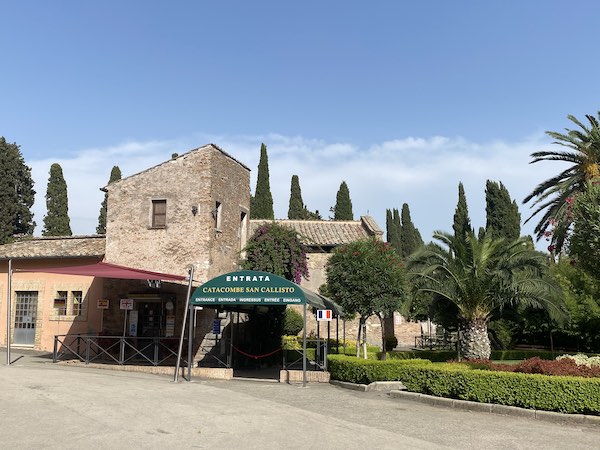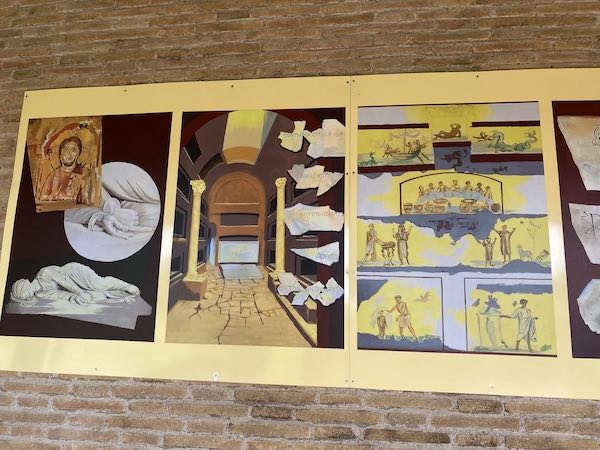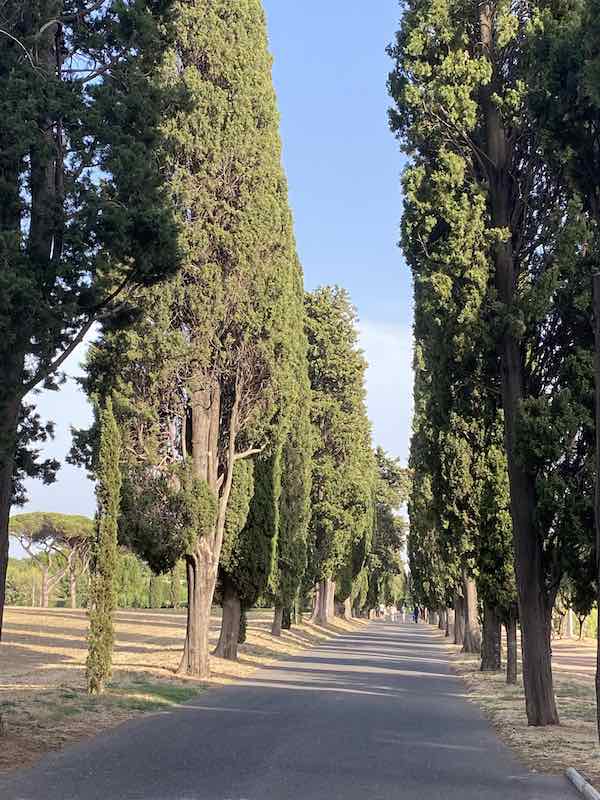All you need to know about Rome catacombs: what they are, where they are, the best catacombs in Rome to visit and how to book a tour.
The catacombs are one of the most fascinating underground attractions in Rome.
Rome’s catacombs are early Christian cemeteries, dating from the early days of Christianity in the Roman Empire.
They develop as an extensive network of underground tunnels and they are one of the most fascinating ancient Christian sites in the city.

There are several catacombs in Rome, all wonderful for different reasons.
In this guide, I share fun and intersting facts about the Rome catacombs and tips to plan your visit.
Since photography is not allowed inside the catacombs, I added images of the outside and the free info panels at San Callisto, showing drawings of the catacombs.
Safe travel planning!
Please note: this post contains affiliate links and, should you make a purchase through them, we might make a small commission.
What are the catacombs of Rome? Essential catacombs facts at a glance
- Rome catacombs are underground, early Christian cemeteries
- The Catacombs of Rome date from the II century AD and stayed in use until the V century
- They are excavated in tufa, a volcanic rock typical of central Italy
- The catacombs spread over several kilometres. The catacombs of St Callixtus alone are over 20km long!
- The catacombs develop over several floors and get to a depth of over 20mt underground
- The catacombs of Rome hosted the remains of many saints, martyrs and Popes
- The catacombs were abandoned in the Middle Ages
- The were rediscovered during the Renaissance(XVI century) and partially restored and made accessible in the XIX century
- There are many catacomb complexes in Rome, only some of which are open to the public
- Visits to the catacombs are by guided tours only
How to visit Rome’s catacombs
There are five catacombs in Rome currently open to visitors and managed by organisations offering guided tours.
Due to the nature of the site, access to the catacombs is by guided tour only: booking is essential.
Need to know: access to the catacombs is by steep steps that are not suitable to people with mobility impairments. Due to the underground nature of this site, the catacombs are always cold: bring a shawl even in the hight of summer! See more tips about what to wear for your visit at the end of this page.

The Catacombs of St Callixtus – recommended for a first visit
The Catacombs of St Callixtus (Catacombe di San Callisto) are the largest in Rome and the most visited.
The are along Via Appia, in an area with several other significant attractions such as the Quo Vadis Church and ancient Roman Tombs.
They are managed by the Vatican, via the Religious Congregation of the Salesians Don Bosco.
Guided tours are available in several languages; you can book online here.
The tour is excellent and aI found it to be the most informative I have take so far.
This is why I recommend this a a tour of choice for a first catacomb visit. the tour is child friendly (school age and up for accessibility and type of attraction – see below)
The Catacombs of Saint Callixtus date from the II century AD and are one of the most important Christian sites in Rome.
They are there esting place of over half a million Christians and count, among their original residents, St Cecilia and many Popes, resting in a chamber aptly called ‘Little Vatican’.
The most noticeable things in the catacombs of St Callixtus are the tunnels themselves, a stunning statue of St Cecilia, now marking her original burial niche, the ancient frescoes in some of the wealthiest chapels and the impressive Little Vatican, a powerful place for Christians especially.
The visit to the Catacombs of St Callixtus lasts about 45 minutes and includes a talk explaining what the catacombs are and how they came to be and a walk though the tunnels.

Catacombs of San Sebastiano
The catacombs of ST Sebastian are also located on Via Appia, only a short distance from those of St Callixtus.
These are among the most ancient catacombs in Rome and are wonderful especially for the beautiful frescoes that still decorate the chamber known as the cubicle of Jonah, dating from the IV century AD.
The catacombs of St Sebastian started as a pagan burial area and became Christian cemeteries in the II century, when they were dedicated to St Peter and St Paul.
They owe their name to St Sebastian, who died martyr in Rome and whose remained where moved here by matron Lucina, who saw the Saint in a dream and felt called to give him proper burial in this location.
You can visit the Catacombs of St Sebastiano with the aid of a guide. You can book your tour here.
Catacombe di Priscilla
The catacombs of Priscilla are located in the north of Rome, close to via Salaria, and are unique as they are where you find the first ever depiction of the Virgin.
The fresco represents Mary with the Christ Child on her lap and dates from the IV century AD.
Access to these catacombs is by guided tour, you can book your ticket here.
These are among the best and most interesting catacombs in Rome.
I recommend a visit especially to visitors with religious interests, Christian art lovers and to families with kids, as they are beside the large Villa Ada park.
Catacombs of Domitilla
Domitilla Catacombs are on Via Ardeatina, in the south of Rome. They have tunnels over 17 kilometers long, they develop over four levels and were the burial grounds of over 150,000 Christians.
They are most famous for being the resting place of St Nereus and Achilleus, who were buried here in the IV century AD and they are also home to a unique site: a partially underground basilica, dating from the Pontificate of Pope Damasus 366-384 A.D.
Access is by private tour only: you can book your ticket contacting the catacombs office directly here.
Catacombe di Santa Agnese
The catacombs of St Agnes are under the stunning Christian complex of St Agnes’ Basilica and Costanza’s mausoleum, in the north of Rome.
The catacombs develop under the church and take their name from St Agnes, who is celebrated here and in the church of Sant’Agnese in Agone in Piazza Navona, where you canals see her relic.
These catacombs are lesser visited than others in Rome; however, they are interesting, especially if you combine your visit to the church of Sant’ Agnese and the unique Christ of Santa Costanza beside it, which is a rare example of round church in Rome.
You can arrange a tour of the catacombs contacting the parish office here
Visiting Rome catacombs with kids
The catacombs are an interesting site for kids; however, due to the nature of the attraction and the the logistics of its accessibility, they may pose challenges to families with small kids.
Based on my experience visiting the Rome catacombs with kids, I believe it is important to know the following things.
The catacombs are not stroller friendly: access is by steep steps and due to the humidity in the tunnels, they can be slippery.
If you plan to visit the catacombs with a baby, a baby carrier and proper shoes are essential.
Also, always hols handrails when climbing down as it is very easy to slip!
I do not recommend visiting the catacombs with a toddler: while it is technically possible, it is of paramount importance that they do not trot ahead or ever leave your side.
Getting lost here is very easy and there are over 20km of tunnels: while safety precautions are in place, it is not a chance you want to take!
They also have no interest for small kids since there is nothing they can touch or engage with except the echo – which is fun for them to experiment with but not ideal for you or anyone else present..
Kids of primary school age and up are likely to love the catacombs: the underground tunnels and the history of the place is likely to pique their attention and curiosity.
However, I recommend you take into account that these are cemeteries and that you will hear stories of gruesome deaths and see the graves of babies and children.
This may or may not be an issue for your children, however, I believe it is essential to be prepared.
A grave of a young child, even if very ancient, is the one thing my daughter remember the most about the whole experience. Preparation is key.
I believe the catacombs are a fantastic site to visit in Rome with teenagers.
Those I recommend with them are those at St Callisto, which you can combine with a bike trip along Via Appia.

More interesting facts about the Catacombs of Rome
The catacombs of Rome are early Christian underground cemeteries.
According to the Vatican, Christian catacombs started under Pope Zephirinus (199-217).
To answer the growing need for a safe burial ground for Christians, he assigned to soon-to-be-Pope Callixtus the task of managing the burial grounds on Via Appia and turn it into a Christian cemetery, able to host the remains of Popes and fellow Christians alike.
The cemetery grew over time and became a vast underground city for the dead.
The same concept replicated in several areas of Rome so now we can visit several catacombs, in different parts of the city.
What are Rome catacombs made of?
The catacombs are excavated in a type of stone that is typical of central Italy and called tufa.
This material is very malleable when underground but become very strong and resistant once exposed to air.
This characteristic means that diggers (fossores, in Latin) were able to efficiently excavate long tunnels and burial slots that were then solid and able to stand the test of time once completed.
The excavation would have started with one layer of underground niches, like a modern cemetery; as the need for space grew, diggers would go deeper, adding more and more corridors.
The biggest catacombs in Rome are over 4 storey deep, each storey hosting several rows of burial slots on each side of its walls and numerous chambers.
What do the catacombs look like?
Pleas note: Photography is not allowed inside the catacombs.
The catacombs are a network of long underhand tunnels.
You enter them by rather steep staircases leading you several stories underground and they spread like tall, meandering corridors.
Along their walls, there are slots excavated to accommodate a lying body. Each wall has several niches, one on top of the other, to allow the use of all the space possible.
Each slot would have been covered with a burial stone and had space for a small oil burning lamp, for light and hygene.
As you walk along the corridors, you also encounter chapels and bigger chambers.
These were mausoleums belonging to the wealthiest families or, in the case of the catacombs of St Callixtus, the burial chapel for Popes.
Overall, you experience the catacombs like an underground city, with streets (corridors), crossroads (the network is vast) and a mix of more modest homes and beautifully decorated ones.
What does ‘catacombs’ mean?
The word catacombs comes from the elating ad catacumbas, which in turn seems to come from the Greek expression kata koumbas = at/among the grottos.
How dark are the catacombs? Can I visit if I suffer from claustrophobia?
Since they are underground, there is not natural light in the catacombs.
The areas accessible to the public are now lit up by electric lighting but, back in the day, the small burial lamps and torches would have been the only light sources.
Currently, the catacombs are not ideal if you suffer from claustrophobia but they are well lit and ventilated, so the overall feeling is not too oppressive.
What to wear to visit Rome catacombs
There are two main items you need to visit the catacombs in Rome:
A shawl or a cardigan and good walking shoes.
The shawl/cardigan is essential in all seasons: the catacombs are cold and stay at a temperature of about 16C/61F degrees.
This is regardless of the temperature outside: the last time we visited, we have 35C/95F degrees out and 16C/61F in – make sure you have an extra layer you can easily out on/ take off!
In terms of shoes, I recommend you opt for comfortable shoes with rubber sole: this is to help you with the long walking required and also to give you extra grip on the steps. Avoid flip flops at all costs.
You can find here >>> my tips on the best shoes for Rome.
I hope you found this quick guide to the Rome catacombs useful and it helped you plan your visit. Safe travels to Rome!
